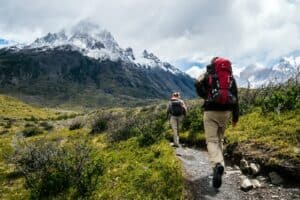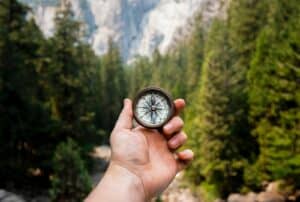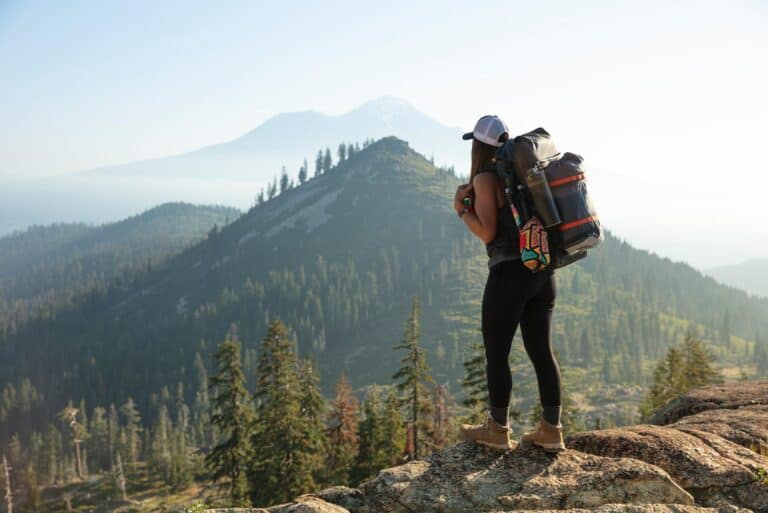If you’re like me, you’re always looking for ways to improve your hiking game. It’s not just about conquering the next big peak, but about enhancing the overall experience. Whether you’re a seasoned hiker or just lacing up your boots for the first time, there’s always room for improvement.
How to get better at hiking? In this article, we’ll dive into some practical tips and tricks to help you get better at hiking. We’ll cover everything from building endurance and strength, to selecting the right gear and knowing how to navigate in the wilderness. So, if you’re ready to take your hiking skills to the next level, keep on reading.
Set Clear Goals for Your Hiking Journey

Start your hiking journey by setting up some clear, achievable goals. It’s crucial to remember that it’s not about how many mountains you’ve climbed, it’s about the enjoyment and learning that comes with the journey.
Hiking can be a powerful tool for personal growth: it builds muscles and endurance, enhances your ability to navigate, and can make you a more self-reliant individual in general. Break your larger goal into manageable milestones. For example, you might start by tackling some smaller, local hikes before you take on that week-long mountaineering trip.
Start by asking yourself: What do I want out of my hiking experience? Is it fitness, an appreciation for nature, or achieving the discipline of regular exercise? Once you have your answers, you’ll have a better grasp of what you should focus on to make your hiking experience truly rewarding.
If you’re hiking for health, consider using a fitness tracker to calculate how far you’ve walked and the number of calories burned. This can help you see your progress and push you to go even beyond what you thought was possible.
You might also want to consider joining a local hiking group. Not only can it be a great source of motivation and support, but experienced hikers can impart valuable knowledge about the best gear, trail tips, and safety precautions.
It’s vital to keep your hike enjoyable – you should look forward to your hikes, not dread them. So, take the time to find a comfortable pace that suits your level of fitness and allows you to relish the journey. Once you get the hang of it, you’ll find yourself pushing forward, always ready to conquer the next trail or mountain.
Build Endurance and Stamina for Longer Hikes
Building endurance and stamina is vital for boosting your hiking experience. You might be asking, “Why is it crucial?” As I’ve mentioned before, hiking’s not just about strolling around. It’s a physically demanding endeavor that requires a strong body and mind.
Start by incorporating regular cardio workouts into your routine. This approach will boost your stamina and prepare your body for the physical toll of hiking. Don’t rush – progress will come over time. You’ll start to notice you’re less winded during hikes and that you’re not as sore afterward.
For an effective endurance-building regimen:
- Alternate between long, low-intensity workouts and shorter, high-intensity ones.
- Always stretch before and after workouts.
- Stay hydrated and maintain a balanced diet.
It’s also wise to remember strength training. Hiking doesn’t just work out your legs, it works your whole body. Incorporating regular resistance training can help prepare your body in a more holistic way, especially if you aim for longer, more challenging hikes.
But perhaps the most effective way to build endurance for hiking is to hike regularly. Just like any other sport, the more you do it, the better you’ll get. Regular shorter hikes can act as training for more extended, more challenging excursions.
Remember not to neglect your mental endurance. Mindset is a significant part of any challenging physical endeavor, and hiking is no exception. Remember to celebrate the small victories, like reaching a tough peak or completing a long hike. This will build your mental resilience and make you more likely to push through when the going gets tough.
At the end of the day, it’s all about finding the right balance that works for you. Everyone’s hiking journey is different, and there’s no one-size-fits-all strategy. By focusing on building your endurance and stamina, you’re setting the groundwork for a more enjoyable, rewarding hiking experience. Next, we’ll be looking at some tools and techniques to help you on the trail.
Strengthen Your Core and Lower Body Muscles

Did you know that hiking isn’t just about endurance and stamina? It’s also about strength, specifically core and lower body strength. Your core and legs are your primary movers on the trail. They basically determine how far and how fast you can go.
Stronger core and lower body muscles can significantly improve your hiking capabilities. That’s why a good hiking workout regimen should definitely include exercises that focus on these muscle groups.
When we talk about core muscles, don’t limit your thoughts to just abs. They also include your lower back and obliques. Various exercises serve this purpose but planks are especially effective. They work almost every core muscle you’ve got.
As for your lower body, your quadriceps, hamstrings, and calves do a lot of work during hikes. Any activity that strengthens these muscles will be beneficial. Squats, lunges, step-ups and calf raises are just a few to name.
Now you should have a good idea of why strong core and lower body muscles are vital for hiking. So, let me help you get started with the right exercises. Here is a sample workout that you can incorporate into your fitness routine:
- Planks: Start with 30 seconds, then increase the time as you get stronger.
- Squats: Three sets of 10 to 15 would be great. If they get too easy, try weighted squats.
- Lunges: Perform three sets of 10 to 15 for each leg.
- Step-ups: Find a sturdy bench or platform and step up and down. Aim for three sets of 10 to 15 for each leg.
- Calf raises: Three sets of 15 to 20 should be just about right.
Start with what you can handle and don’t rush the process. Patience pays off in fitness as much as it does in life. Just stay consistent with your training, and you’ll notice significant improvements in your hiking performance.
Choose the Right Gear for Comfort and Safety
An essential part of hiking preparation involves finding and using the right gear. Comfort and safety are pivotal, as they can make or break your hiking experience. Whether it’s the shoes on your feet or the bag on your back, each piece of gear plays a significant role in your journey, and selecting wisely can help you boost your performance.
Specific Hiking Shoes provide the stability and grip needed for varied terrains. They’re designed to protect your feet and ankles from injury while yielding comfort during long treks. It’s recommended to try them on, walk around, and ensure a good fit before your hike. Consider the type of terrain you’ll be traversing, and pick shoes that are designed to handle it.
When contemplating your Backpack, size and storage capability are critical factors. It should be comfortable on your shoulders and spacious enough to carry your necessities. Hydration reservoirs, snack compartments, and other beneficial features make for better and easier navigation. Remember, it’s not about having the biggest bag, but the most suitable one for your needs.
Clothing and Accessories, like light, moisture-wicking garments and sturdy hats, can protect you from environmental elements. Invest in weather-appropriate attire to avoid getting cold, overheated, or sunburned. In colder conditions, thermal layers can be invaluable. Similarly, accessories such as hiking poles or GPS units can enhance comfort, safety, and navigation.
Lastly, don’t forget the importance of general safety kits. First Aid Kits and Whistles are great examples to include in your hiking gear. A modest first aid kit with bandages, antiseptic wipes, and any personal medications is recommended. Whistles can alert bears or other wildlife of your presence, reducing potential encounters, or signal distress during emergencies.
Select gear that matches your needs and the specific trail conditions, and gradually upgrade as your hikes become more challenging. It’s not a sin to splurge a bit on gear if it enhances your hiking performance. But remember, the best gear should ultimately help you enjoy the trails safely and comfortably.
Learn the Art of Navigation in the Wilderness

After you’ve got your gear dialed in, it’s crucial to learn the art of navigation in the wilderness. This is especially vital in case of emergencies, or when hiking on unfamiliar terrain. Let’s delve into effective ways to improve your navigation skills when hitting the trails.
Master Map Reading and Compass Use: Nothing beats the old reliable map and compass when it comes to wilderness navigation. A compass isn’t just for pointing North, but it’s a powerful tool in pairing with a map. It can help you identify landmarks, determine your location, and map your route. If you’re yet to harness its potential, consider joining a map reading or a compass use workshop.
Get Familiar with GPS and Modern Tech: While traditional navigation tools are indispensable, it’s important not to overlook modern tech. Tools like GPS devices, smartphones, and smartwatches can provide valuable data and additional safety. However, make sure to carry spare batteries or a power bank, as these tools rely on battery power.
Understand Trail Markers and Signs: Most hiking trails have inherent marking systems. They may include painted marks on trees (also known as blazes), cairns, and signages. Familiarizing yourself with these markers will make navigating trails a breeze.
Trust Your Instincts: At the end of the day, trust your instincts. They have a strange way of being right. If a path feels wrong, it’s okay to go back or find a safer route.
By mastering navigation, you’ll not only make your hikes more efficient, but also safer. You’ll never have to worry about getting lost, and you’ll be able to hike with confidence. As I always say, “A prepared hiker, always enjoys the journey more.” The joy obviously isn’t just about getting better gear, but also about knowing where you’re going and how to get there.
Conclusion: How to Get Better at Hiking
Let’s face it, getting better at hiking isn’t just about the physical. It’s about the mental too. It’s about knowing your way in the wild, understanding the language of nature, and being able to navigate your way through it.
Mastering navigation skills isn’t just a bonus, it’s essential. It’s your lifeline when you’re out there in the wilderness. It’s what makes you efficient, it’s what keeps you safe.
Remember, it’s not just about the gear, it’s about the knowledge. It’s about knowing where you’re going and how to get there. So, don’t just prepare your backpack, prepare your mind too. Because when you’re out there, that’s what will truly make the difference.
So, keep learning, keep practicing, and keep exploring. Because the more you do, the better you’ll get. And the better you get, the more you’ll enjoy every hike you take.


